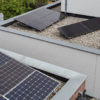A solar PV system is a significant investment, no matter how you look at it. Most residential systems cost north of $5,000, after all. But purchasing a PV system means more than just free electricity and energy independence.
You’re no longer an energy consumer, rather you’re now an energy seller. Most PV systems not only power the homes they’re on, but add to their neighborhood’s grid too, making it more secure and robust.
But, energy economics is an intricate, technical and, in the case of solar power, often erratic process. Obviously, you’d like to know your system is performing as best as it can, as long as it can — something that’s not really possible with regular, metered PV systems.
For most solar homeowners, their monthly utility bill informs them on how much power their systems produced. But, bills are a rather poor way to determine solar power system performance.
A dip in earnings can always be attributed to increased, untracked power usage, after all. However, it could very well be your solar PV system that’s not performing as it should.
But, What Could Possibly Go Wrong with My Solar Power System?
Don’t get us wrong. Solar power systems are fairly robust and can take quite a bit of beating. Even so, there are factors that can affect their performance.
A bad panel orientation, dirt build up, output power derating due to temperature differences, cable inefficiency and shades due to new or un accounted for structures, all can affect your PV system’s performance.
For example, research has shown that inverters alone can account for 18% of power losses from PV systems. Likewise, shading can result in a loss of 33%, while cable losses can be up to 1.7%.
Many buyers of solar take a set and forget approach and think “well if my electricity bill has dropped my solar must be working”. No. no, because a well designed quality system will have a significant impact on your electricity bill and there is no way of knowing if the system is performing to specification and warranty by power bill review, simply no way!
Unfortunately, there’s no way to know if any of these might be applicable to you through regular means. While there are smart inverters available that can run a rudimentary analysis, they are by no means deep or even complete.
You can however add smart solar software you can trust from Australian company Solar Analytics. Using a variety of hardware solutions it will provide near real time analysis, automated alerts if there is a problem and has a fantastic payback tracker so you can watch your savings grow! Quite simply, it will help you get more from your solar.
What is Solar Analytics?
Solar analytics is a software service that monitors PV systems and home electricity usage in real time.. The system consists of a small unit that goes into the switchboard along with clamp type sensors to measure electricity usage patterns or can pull data directly from approved inverters.
The data is then sent via the cloud where smart algorithms analyse system performance which in turn send data via either 4G or WiFi to an elegant and easy to understand dashboard which can be viewed on any device.
The difference between Solar Analytics and conventional monitoring is that they do all the hard work for you. It monitors the system day in and day out so you dont have to and most importantly will only send you an alert if anything major goes wrong. It will accurately track your savings from day 1 and allows you to compare solar generation to actual usage so you can increase your savings. But, it does even more.
Solar Analytics is the only residential solution which uses satellite and weather data to forecast what your system should be producing, which they call Performance Monitoring. You can see not only what it produced but what it should have produced and its all done automatically. It also compares your solar PV’s output relative to how systems in your neighborhood are performing to give a better picture.
Additionally, the system can measure grid voltage across 1,2 or even 3 phases with impressive accuracy. These features allow Solar Analytics to see past a module’s published specs, and understand its performance holistically in a real world setting.
Since it’s using third party data sources besides the solar panels it’s hooked up with, the data and insights it generates are far more accurate and reliable than its standalone peers.
Should You Get Solar Analytics?
The answer depends on your comfort level and requirements. Do you really want to track your savings and payback time ? Are you intrigued by the prospects of drawing as much value out of your system as possible? Do you really want to get more from your solar? If so, then Solar Analytics is a must have.
Savvy solar buyers are looking to maximise their savings through solar, so including Solar Analytics makes perfect economical sense and adds very little to the cost of a system.
Obviously, installing Solar Analytics adds to your total investment but will pay for itself quickly with more savings, more transparency and by ensuring your solar is delivering on the promise. Solar Analytics is so confident it can help you save more, it even offers a Savings Guarantee with its Lifetime service. With over 50% of solar installations either underperforming or not at all on any given day, we think it is a wise inclusion.
Of course, all solar systems produce slightly different amounts of energy, in different locations and are affected by many factors. That’s where Solar Analytics proprietary Performance Management service makes life simple because it takes these variables into account.
Conclusion
At face value, Solar Analytics seems like an obvious part of any solar power system. Isn’t more information better? Indeed, if you want to get more from your solar investment, then Solar Analytics is the way to go.
Of course, any investment must make financial sense. If the cost of installation adds an unacceptable figure to your payback period, or, if you’re happy to regularly check, analyse and monitor your system yourself then a more basic monitoring solution may make more sense.
Interested in finding high-performance solar PV systems at the lowest prices? Use bidmysolar™ to compare the best solar products in Australia.





